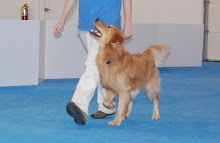Luring is not evil. You are not a bad person if you lure behaviors.
If you do a bad job of it....then you get your own set of problems.
Practice Following: We treat it as a magnet and fairly closely follow some of the notes in Agility Right From the Start book on "treat transport". The dog should be licking-sniffing the treat the whole way. If his tongue is not on your hand, your had is too far away. Move slow enough so that he can be licking the whole time. This will allow you to carefully control and refine his movements.
Select For Your Behavior, Reinforce Approximations: If you are getting a down...you may release the treat when you see shoulders drop. A few repetitions later, release the treat when elbows hit the floor. And after a few reps of that...release the treat when the back end hits the ground.
Get A Good Behavior: There's some crazy popularized rule to "lure 3 times then no more food in the lure hand" . I've not found that to be a good rule to follow. I use food in the hand until the dog is -immediately- getting into position, efficiently getting into position, and I have the shape of the behavior I want. Then...some reps with no food in the hand, but same motion, feeding treats as soon as the dog responds.
Cue Transfer: At that point... New Cue (verbal or signal), pause, old cue (lure hand with no food in it). Reward.
Should I Use a Clicker? I often don't. But sometimes I have students...this helps them be exact about when to release the food. Otherwise they like to as for too much, too soon.
When to Lure? There are a few places where I am pretty happy and enthusiastic about using a lure: Fold back downs and kick back stands. I have ways to shape and get that down, but nothing great for the kick back stands. I'm not a targeting enthusiast..... but that could be another option. I feel like I can refine movements better with the lure than with a target stick.
I have students lure some behaviors...downs, stands, sometimes sits. On occasion, I let them get away with luring around cones and that sort of thing. It depends on their ultimate goals and what my goal is for the specific lesson.
Luring is Horrible! I've read a few really offensive things recently.... luring really isn't that horrible. It has a few advantages over other ways to get behavior. It has disadvantages. If luring is used well...it doesn't mean someone is a poor trainer or cheating or whatever else. And I feel quite strongly about that. At the same time, I'm still sometimes feeling guilty for luring behaviors!
Seminar weekend..... I'm going to have too much to say about it, provided I understand what's said!
Friday, September 23, 2011
Subscribe to:
Post Comments (Atom)




2 comments:
How do you lure a kickback stand?
I like to explain luring as magnets.
"Have you ever played with magnets? When you hold them far apart, you can move them independently, what you do with one doesn't have much effect on the other. But if you hold them close, so close they're touching, moving one is going to move the other."
I got a lot of people in my puppy class that would show the dog the treat and say "Sit," expecting their 12 week old puppy to move away from the treat to get the treat.
You are way more clever than me.... my magnet example is about refrigerators.
Kick back stand: A video is on my to-do list....
Treat on dog's nose. Lick lick lick. SUPER SLOW move it straight out (not upwards, not down... nose height). Keep moving it out....super slow. at some point the dog will either pop up into a beautiful stand. Or the dog will start to and you can click those back leg twitches or pushes.
I think the lure prompts the dog to shift his weight forward...allowing him to pop up with the back end. The lure also stops the dog from just walking forward because of the super super slow movement.
Post a Comment